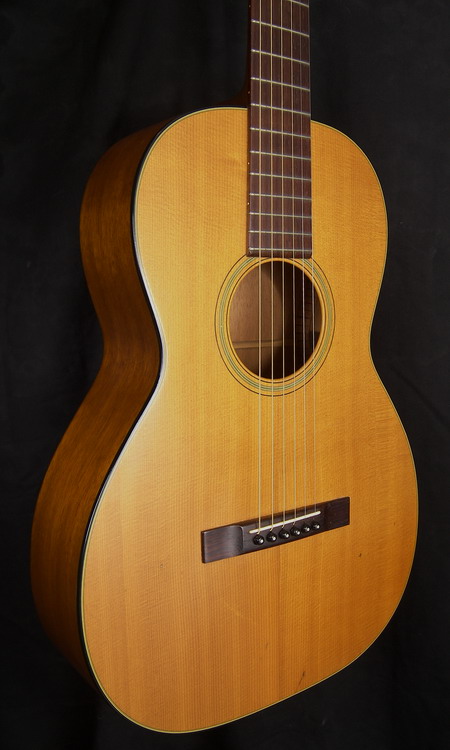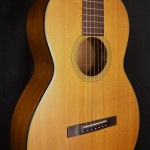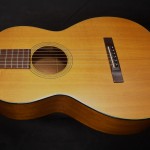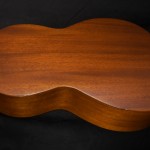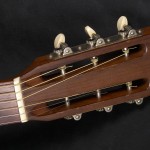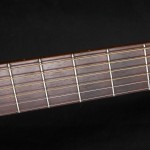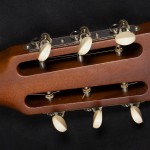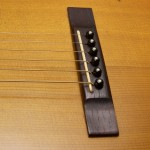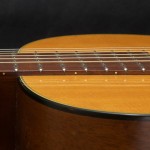The Martin 0-16NY was made from 1961 until at least 1992 and in that time 6,138 were made. Being a Size 0 it is 13.5” in body width, has a Sitka spruce top and mahogany sides and back, a Brazilian rosewood headstock overlay,brazilian fingerboard and rectangular pin bridge. It is a slothead with a 1 7/8” nut width and a 2 ¼” string spacing at the bridge. The unbound rosewood fingerboard has no markers on the front surface but 7 white dotmarkers on the bass side. The top is bound with tortoise shell color celluloid, the back is unbound; the top also has black-white four ply purfling around its perimeter. The nut on this guitar is quite white and probably replaced, the side mounted tuners are filigree etched with crème buttons and appear original; the bridge saddle is set rather low but the action, with silk and steel strings is comfortable. The guitar shows light normal signs of use.Comes with a modern Martin C 630 case.
There is an excellent discussion of the 0-16NY available at “The Unique Guitar Blog: http://uniqueguitar.blogspot.com/2010/05/martin-0-16ny.html In 2004 the C F Martin Guitar Company came out with a model guitar that was loosely based on the 0-16NY that Jethro Tull’s Ian Anderson purchased back in 1972. However the Martin reissue wasn’t of the 0-16NY, exactly. It was a rosewood guitar called 0-28 that (coincidentally) came standard from the factory with a pickup. That model had a Martin MAP of $4339 and this guitar is less than half of that. Besides, Anderson used the 0-16NY in Jethro Tull, not an 0-28. This is an enormously likeable instrument with a memorable and illustrious sound that, when you hear it, you will no doubt remember with aching fondness.
The Martin 0-16NY
1961 was the year that could be written upside-down and it would still be the same. This was the year that ushered in a new page in American music history called The Folk Era.
Driven by a handful of people that gathered in some Greenwich Village Clubs or on Washington Square carrying old acoustic guitars, banjos and bass fiddles, they interrupted Rock music briefly with strains of Kumbaya and Tom Dooley.
Seriously, there were some excellent musicians from those days that changed music and the world as we knew it. Guitar manufacturers jumped at the chance to produce instruments that would appeal to these folksie folk song types. C.F. Martin was no exception.
| Martin 0-21 NY and 0-16 NY |
This same year two new Martins were introduced; The O-16NY and the 00-21. These guitars hold the distinction of being the first vintage re-issues of a guitar. By 1961 the popular Martins were series D guitars.
Perhaps Joan Baez’ and Joni Collins’ preference for small bodied Martin 12 fret instruments that caught the eye of Martin designers that served as a basis for the 0-16NY. This guitar was different from other Martins of the day. It was designed for finger picking and it was designed to have the appearance of a pre-war 1898 Martin, which incidently were built in New York.
There was nothing fancy about this guitar. This is noted by the designation “16”. The body had a satin finish with no pickguard. The top was solid sitka spruce. The back and sides were solid mahogany. The bridge was a straight piece of rosewood. The mahogany neck bore a Brazilian rosewood fingerboard and had very small side markers, but none on the front of the fingerboard. There was one large ring enclosed in two small rings around the soundhold. The perimeter of the top was bound with tortoise shell binding material.
There was no binding on the back or binding material separating the book matched back. The mahogany neck was wider than a size D Martin. The nut was 1 7/8th and nearly as wide as a classic guitar. The scale was 24.9″. The headstock was slotted and the overlay was Brazilian rosewood.
The tuners were open with plastic buttons, although some models made toward the end of the run, had solid head stocks. The neck had no volute. The top of the body was braced very lightly with an X bracing and only one tone bar.
These guitars were advertised as being able to handle steel or nylon strings. Most owners string them with very light guage steel string. But after returning my 0-16NY to the factory twice I was told by a Martin representative, this guitar was very lightly braced and actually designed to use silk and steel strings. Remember, these guitars did not have a truss rod. The 0-16NY was manufactured up through the early 1990’s.
Martin catalogue shows the last 0-16NY and by that time the slot head was gone.
Here is a 1992 Martin 0-16NY. Look closely at the wonderful straight grain in the wood. It is a beautiful instrument.

